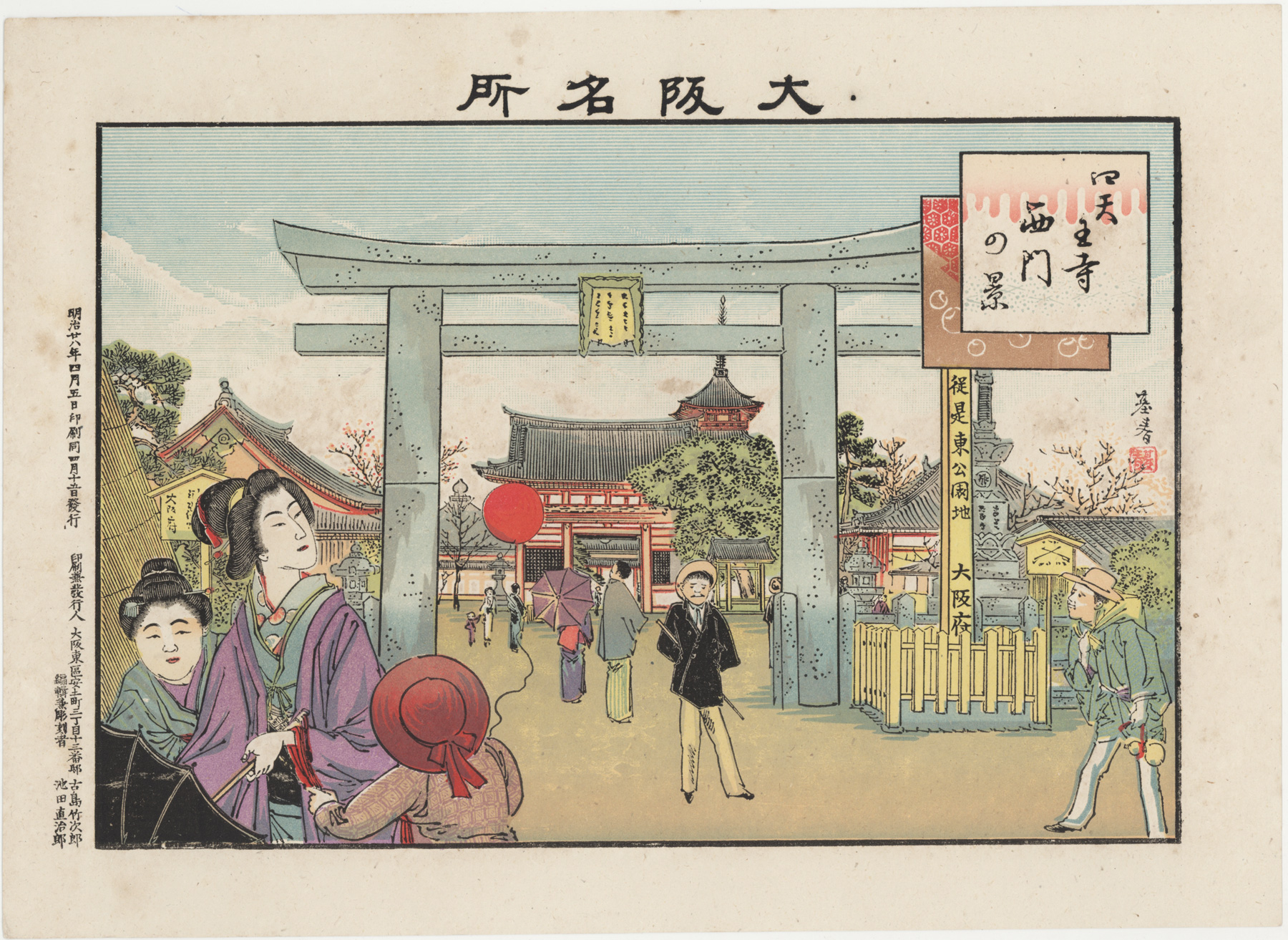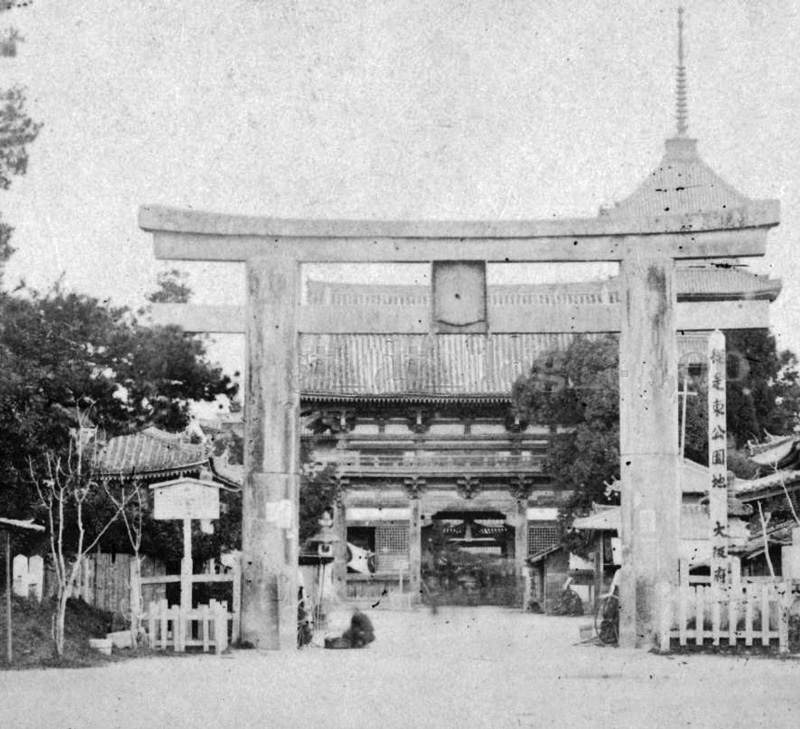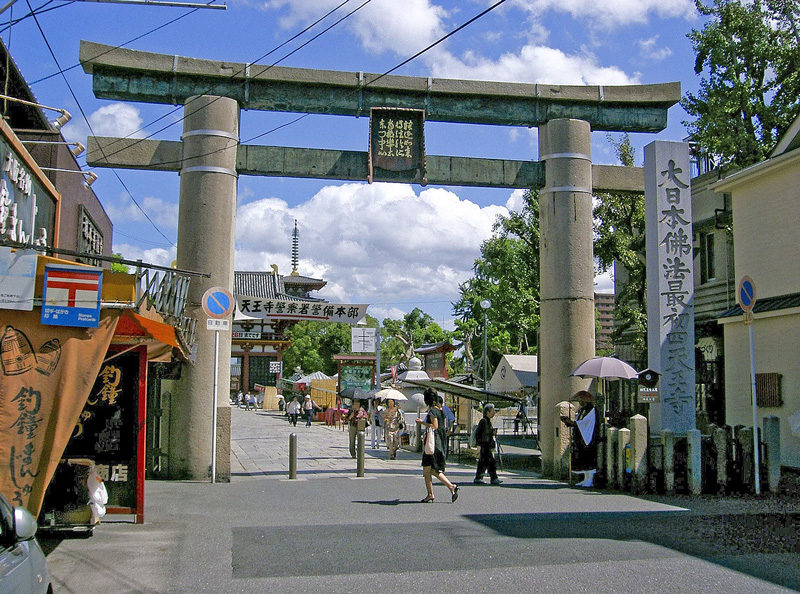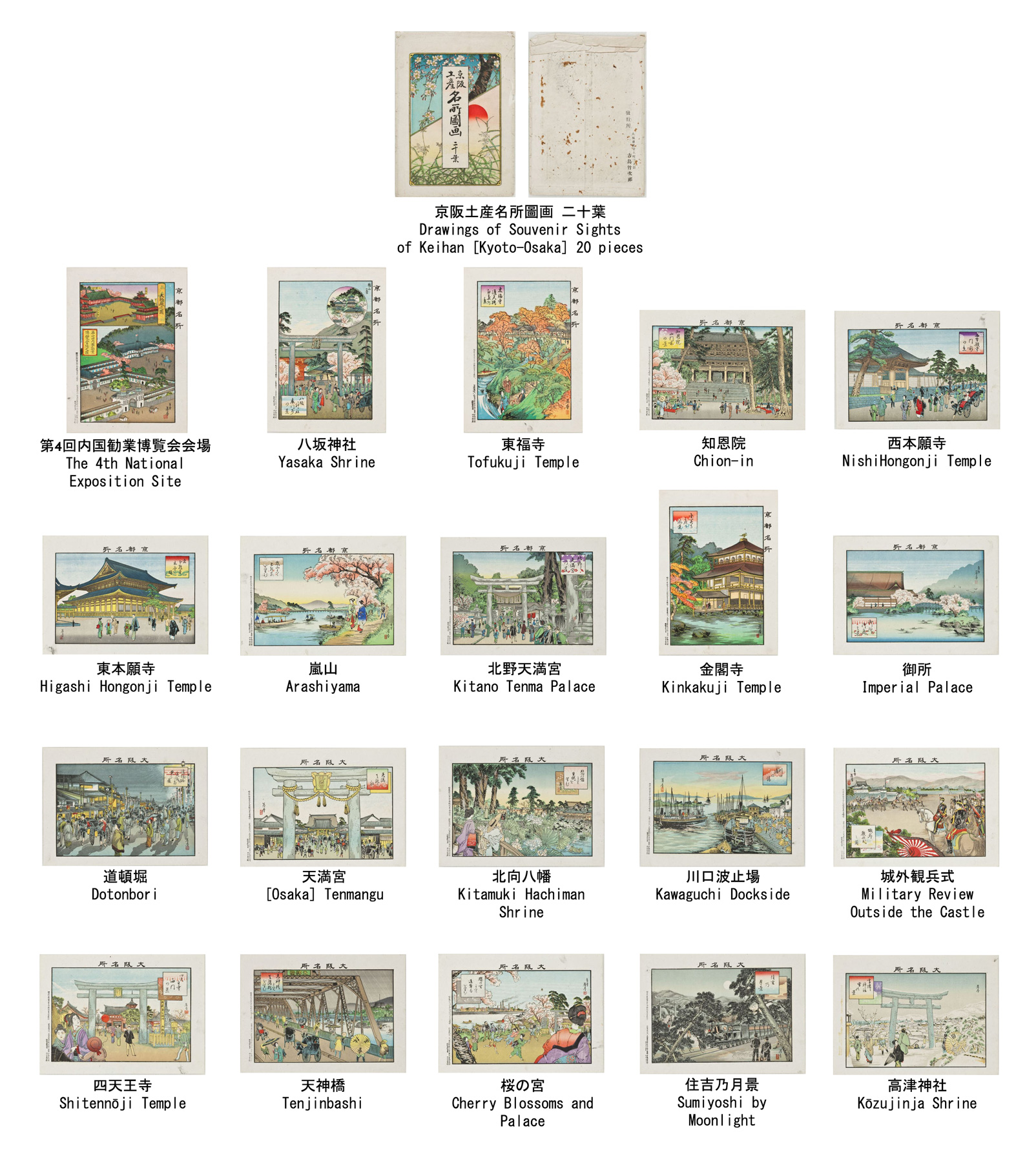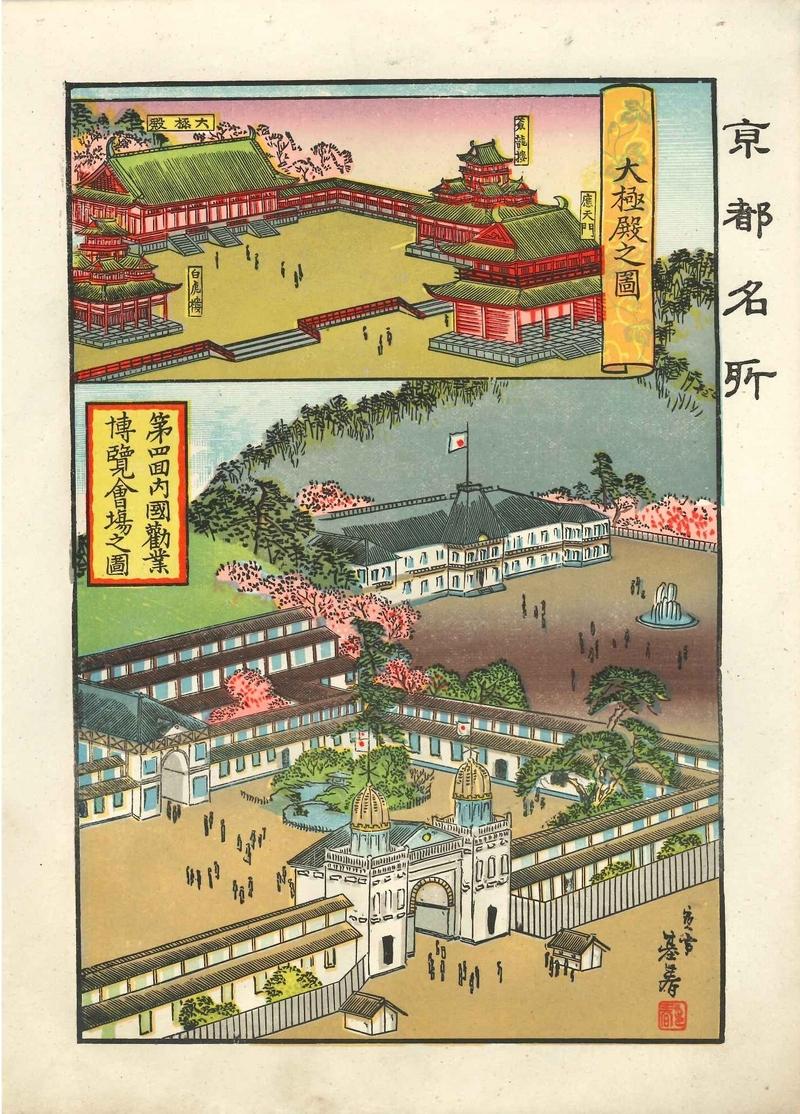About This Print
Visitors in traditional and Western dress near the stone torii leading to the West Gate (Gokuraku mon) of Shitennnōji. The five-storied padoda (Gojūnotō) can be seen in the background. The yellow sign pillar to the right of the torii reads 従是東公園地 大阪府, telling us that we are at the affiliated East Park area in Osaka prefecture.About Shitennnōji
In the first year of the reign of the Empress Suiko (593 A.D.) a Buddhist Buddhism, temple called Shitennōji was established in Naniwa (now Osaka), and in connection with it were founded a poor asylum, a free dispensary, and a charity hospital.1
"The Shitennō (Four Heavenly Kings, also called the Guardians of the Four Directions, Four Celestial Guardians), protectors of Buddhist law and of humankind, are four gods (devas) often found standing at the four corners or along the four sides of Buddhist temples or altars. From the eighth century on, all four are depicted as warriors, wear armor, carry military weapons, stand with one foot crushing a demon beast, and are usually very ferocious looking. Jikokuten is the guardian of the east and maintains the world; Zōchōten guards the south and relieves people of their suffering; Kōmokuten, guardian of the west, sees through evil; and Tamonten guards the north and listens to prayers and protects holy places. Jikokuten holds a sword, Zōchōten a spear, Kōmokuten a writing brush in his right hand and a sutra scroll in his left, and Tamonten a treasure in his left hand and a spear in his right. If there is any paint left on the statues, Jikokuten will be green, Zochoten white, Komokuten red, and Tamonten blue.
"The temple Prince Shōtoku built in their honor was organized in four parts, each with the purpose of helping the Japanese people attain a higher level of civilization. This Shikai-In (Four Institutions) is centered around the seven-building Garan (Central Complex) in which a Kyoden-In (Institution of Religion and Education, of which the present IBU is a part) was housed. This Garan consists of a Five-Storied Pagoda, a Main Golden Pavilion (Kondō) housing an image of the Nyorai Kannon, and a Lecture Hall (Kodō) enclosed by a covered corridor containing three Gates (the Deva Gate, the Western Gate, and the Eastern Gate), and surrounding this central complex are the Great South Gate (Nan Dai Mon) Middle Gate (Chumon), and an East Gate (Higashi no Mon). To the west is a Stone Torii Gate, and to the east of that another gate that is widely accepted as the Eastern Gate to the Western Paradise. To the north of this Garan, Prince Shotoku built a Hiden-In (Welfare Institution), a Ryobyo-In (Hospital), and a Seiyaku-In (Pharmacy) for the purpose of providing essential care to the people of Japan. All four of these institutions are still active today, providing a wide variety of direct support to all in need."2
similar to an aquarium today. At this facility, eels, carps, crucians and other fish were exhibited. Unlike a traditional display style in which visitors were able to observe fish from the top of a water tank, this facility's style was characterized by the fact that visitors were able to see the fish from the side of the water tank. However, seawater fish were not exhibited at the facility. Such fish were displayed in a fish preserve installed at Waraku-en, an amusement park in Wada Cape, Hyogo Prefecture.
last revision:
Source: By I, KENPEI, CC BY-SA 3.0, https://commons.wikimedia.org/w/index.php?curid=2794312
1 Fifty Years of New Japan (Kaikoku gojūnen shi), Okuma Shigenobu and Marcus Huish, Smith, Elder, & Co., 1909, p. 287.
About The Portfolio "Souvenir Drawings of Famous Sights of Keihan" [Kyoto-Osaka]
This portfolio of color lithographs 色石版画 consisted of ten well-known scenes in Kyoto and ten famous scenes in Osaka. It was issued by the Osaka publisher Furushima Takejirō. This 1895 portfolio is the earliest use of color lithography, most likely using zinc plates, for the production of meisho-e, or pictures of famous places. The portfolio was sold in shops in the exposition hall and in souvenir/gift shops around Kyoto. The selling price and number of total copies is unknown, but it appears that at least two editions of this portfolio were produced. As over 1.3 million people attended the exposition, the print runs must have been quite large.
The Fourth National Industrial Exhibition in Kyoto
Source: National Diet Library website http://www.ndl.go.jp/exposition/e/s1/naikoku4.html
The Fourth National Exhibition Site from Souvenir Drawings of Famous Sights of Keihan | The Fourth National Industrial Exhibiition was held in Okazaki Park in Kyoto City from April 1, 1895 through July 31, 1895. It was the first industrial exhibition held in Japan outside of Tokyo. The host city of the fourth National Industrial Exhibition was Kyoto, which wished to overcome its sluggish conditions generated after the transfer of the Japanese capital to Tokyo. Initially, the fourth National Industrial Exhibition was planned for 1894. However, the people of Kyoto strongly hoped that the exposition would be held in 1895 as an event commemorating the 1,100th anniversary of the establishment of Kyoto. In 1894, the Sino-Japanese War broke out, but based on the judgment that industrial promotion was important even in war time, the government decided to hold the exposition in 1895 as scheduled. The venue was located to the south of Heian Jingu Shrine, with a total venue area of 178,000 m2, and a total structure site area of 47,000 m2. A marble fountain was constructed in front of the venue, and on both sides of the fountain was an array of shops. The main structures were the following six: the Fine Art Building, the Industrial Building, the Agricultural and Forestry Building, the Machinery Building, the Marine Production Building, and the Animal Building. At the Machinery Building, electricity replaced coal as the power source. In front of the Marine Production Building was the Exhibition Room of Aquatic Living Things, a facility |
At the Fine Art Building, Seiki Kuroda, a Japanese artist who had returned from France, exhibited a nude with the title of Chosho (Make up in the morning), (which was subsequently destroyed in a fire), arousing great controversy regarding the disturbance of public morals. Eventually, it was decided to continue the display of the picture on the condition that a part of the picture would be covered with a cloth. This controversy was featured in a cartoon by G. Bigot.
Another main feature of the exposition was that a streetcar was operated outside the venue as an official means of public transportation for the first time in Japan. The streetcar ran from Shichijo, Kyoto, to the area around the venue near Heian Jingu Shrine, and also to the vicinity of Lake Biwa Canal. Running southward to Fushimi, the electricity for the streetcar was powered by the water from the canal. It can be said that it served as a symbol of the coming of the electricity period. Although the exposition was somewhat controversial, it came to a highly successful end, drawing 169,098 items from 73,781 exhibitors, as well as welcoming 1,136,695 visitors. For the event, streets and accommodation were improved, providing the basis for Kyoto's establishment as a sightseeing destination.
Print Details
| IHL Catalog | #1947 |
| Title or Description | View of the West Gate of Shitennō-ji Temple 四天王寺西門の景 |
| Series | Souvenir Drawings of Famous Sights of Keihan [Kyoto-Osaka] 京阪土産名所図画 |
| Artist | Hayashi Motoharu (1858-1903) |
| Signature |  |
| Seal | 基春 Motoharu (see above) |
| Publication Date |  printed: April 5, 1895 明治廿八年四月五日印刷 issued: April 15, 1895 同四月一八日発行 |
| Publisher |  印刷兼發行人 [printing and publishing] 大阪...[Osaka - address of publisher] 編輯兼彫刻者 [editing/compiling and engraving] 池田直治郎 [Ikeda Naojirō] Source: website of Stategic Management Laboratory Inc. https://sml.co.jp/documents/toppan-ichida.html?page=5 Furushima created both lithographs and woodblock prints and was a member of the Copperplate and Lithography Association of the Osaka Chamber of Commerce which had 27 companies listed as members in 1894. |
| Carver | not applicable |
| Printer | |
| Impression | excellent |
| Colors | excellent |
| Condition | excellent |
| Genre | kaika-e; meisho-e |
| Miscellaneous | 色石版画 color lithograph |
| Format | chuban |
| H x W Paper | 7 3/8 x 10 3/16 in. (18.7 x 25.9 cm) |
| H x W Image | 5 13/16 x 8 5/8 (14.8 x 21.9 cm) |
| Literature | |
| Collections This Print | Osaka Municipal Library 書誌ID 0000519413 [entire portfolio]; Yamagata Museum 資料番号 6C007465; Kainsai University Research Center for Cityscape and Cultural Heritage of Osaka [partial portfolio]; Kyoto Institute, Library and Archives 歴:地下1階書庫B K1||291.62||H48||/556886 |
7/15/2020
1/13/2019
12/26/2018
![Illustration of Military Review Outside [Osaka] Castle from the portfolio Souvenir Drawings of Famous Sights of Keihan [Kyoto-Osaka]](../hideo-hagiwara-1913---2007-/germination-2/Prior-print-rev1-30x30.jpg)

